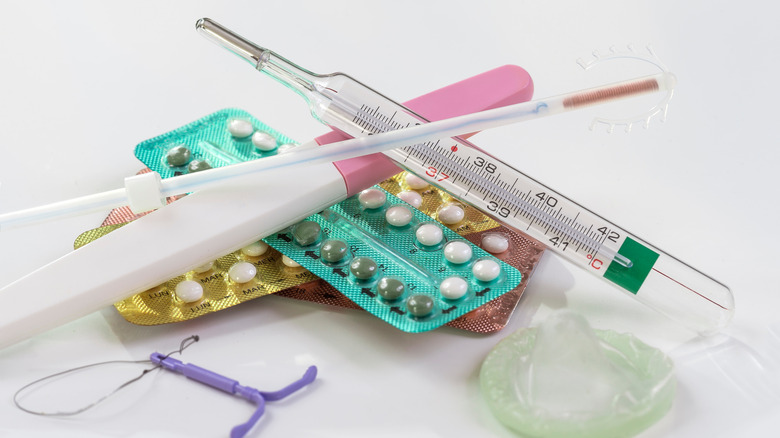The Real Risk Of Getting A Blood Clot From Birth Control
All medications come with side effects, and that includes birth control. You've probably heard from your prescribing doctor that there is a risk of blood clots when taking hormonal birth control. How high is that risk? What symptoms do you need to know about in case you do have a blood clot?
Everyone is at risk of getting a blood clot, but some things can increase that risk. About one to five out of 10,000 women not on birth control will develop a blood clot. That risk goes up to three to nine out of 10,000 women when you're taking a combined oral contraceptive, one that has both estrogen and progestin. Your risk of a blood clot is highest during pregnancy and 12 weeks postpartum, according to the FDA.
Combined birth control methods have many benefits, like helping to treat endometriosis and fibroids and reducing the risk of some cancers. They can even help reduce acne, period cramps, give you lighter bleeding, and shorter periods. But they do increase your risk of getting a blood clot called deep vein thrombosis (DVT) — a blood clot in a vein, usually in your arm or leg, and if you don't get treatment, that can quickly lead to pulmonary embolism — blood clots in your lungs. Combined birth control methods are oral contraceptives, the ring, and the patch (via the American College of Obstetricians and Gynecologists). Which birth control method is best for you and your health?
What about non-combined birth control methods?
If you have a history of blood clots, have a high risk of getting a blood clot, or are breastfeeding, your gynecologist will recommend a mini pill. Mini pills are oral contraceptives that only contain progestin — there is no estrogen. Unfortunately, a combination birth control method is much more effective than a mini pill at preventing pregnancy.
A mini pill also has to be taken at the same time every day. If you can't remember to take your pill at the same time every day, the effectiveness of the medication will decrease substantially, and you'll have to use other methods of birth control like condoms. Good news if you're forgetful — there are plenty of alternatives. Other birth control methods you can use are the ring, patch, implant (Nexplanon), intrauterine device (IUD), or shots (Depo-Provera).
Consult with your gynecologist to determine which birth control method is right for you. There are several options, and there are options within those choices, too, like the amount of hormones in them. There are pros and cons to all of them, and some are better for you than others, depending on your current needs and health conditions (via the Mayo Clinic and Healthline). There are things you can do to lower your risk of getting a blood clot.
How to lower your risk of blood clots
Watch for signs of a blood clot — swelling, blueish or reddish skin, pain, warmer skin in one area, difficulty breathing, cramp in your calf, and soreness. While blood clots can happen anywhere in your body, they are typically in your arm or leg when taking birth control. Be aware of the signs so you can get to the hospital quickly to prevent those clots from getting worse, especially moving to your lungs and causing clotting there, making it hard to breathe. You should seek immediate emergency healthcare anytime you have trouble breathing (via Healthline and WebMD).
You can reduce your risk of blood clots while taking birth control. Quit smoking, eat healthy foods, exercise regularly, make sure you're getting enough water daily, avoid being sedentary, limit your salt intake, avoid tight-fitting clothes, and lose weight if you're overweight. If you have a desk job, set a timer for every 30 to 60 minutes to get up and walk around. Avoid sitting or standing still for too long. Moving is vital for your health and reducing your risk of a blood clot (via the Agency for Healthcare Research and Quality, Harvard Health, and the National Blood Clot Alliance).



